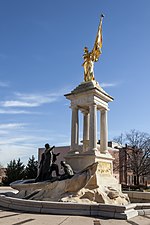Home of the Friendless (Baltimore, Maryland)
Baltimore Registered Historic Place stubsBuildings and structures on the National Register of Historic Places in BaltimoreOrphanages in MarylandResidential buildings completed in 1870Upton, Baltimore

Home of the Friendless is a historic orphanage at Baltimore, Maryland, United States. It is a three bay wide, five story high Second Empire style brick building constructed in 1870 as an orphanage. The building provided a home for orphaned and deserted children for six decades and was part of a three-building complex that housed from 100 to 200 children each year. By 1922 the Board of Managers and Trustees had decided to sell the property and move to the suburbs. The institution is now known as Woodbourne Center.Home of the Friendless was listed on the National Register of Historic Places in 2003.
Excerpt from the Wikipedia article Home of the Friendless (Baltimore, Maryland) (License: CC BY-SA 3.0, Authors, Images).Home of the Friendless (Baltimore, Maryland)
Druid Hill Avenue, Baltimore
Geographical coordinates (GPS) Address Nearby Places Show on map
Geographical coordinates (GPS)
| Latitude | Longitude |
|---|---|
| N 39.302222222222 ° | E -76.629166666667 ° |
Address
Druid Hill Avenue 1320
21217 Baltimore
Maryland, United States
Open on Google Maps










